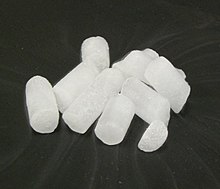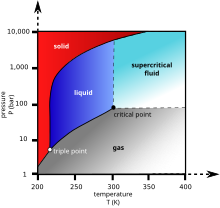Dry ice




Dry ice is solid carbon dioxide.[1] It is commonly used as a versatile cooling agent.
Dry ice sublimes, changing directly to a gas at atmospheric pressure. Its sublimation and deposition point is −78.5 °C (−109.3 °F). Its enthalpy of sublimation (ΔHsub) at −78.5 °C (−109.3 °F) is 571 kJ/kg (245 BTU/lb). Dry ice density is usually between 1.2 and 1.6 g/cm³. The low temperature and direct sublimation to a gas makes dry ice an effective coolant, since it is colder than water or ice and leaves no moisture as it changes state.[2]
History
In 1835 the French chemist Charles Thilorier published the first account of dry ice.[3][4] Upon opening the lid of a large cylinder containing liquid carbon dioxide, he noted much of the carbon dioxide rapidly evaporated leaving solid dry ice in the container.
Manufacture
Dry ice is readily manufactured:[5][6]
- Gases containing a high concentration of carbon dioxide are produced. Such gases can be a byproduct of some other process, such as producing ammonia from nitrogen and natural gas, or large-scale fermentation.[6]
- Carbon dioxide-rich gas is pressurized and refrigerated until it changes into its liquid form.
- The pressure is reduced. When this occurs some liquid carbon dioxide vaporizes, and this causes a rapid lowering of temperature of the remaining liquid carbon dioxide. The extreme cold makes the liquid solidify into a snow-like consistency.
- The snow-like solid carbon dioxide is compressed into either small pellets or larger blocks of dry ice.
Dry ice is typically produced in two standard forms: blocks and cylindrical pellets. A standard block weighing approximately 30 kg is most common. These are commonly used in shipping, because they sublimate slowly due to a relatively small surface area. Pellets are around 1 cm in diameter and can be bagged easily. This form is suited to small scale use, for example at grocery stores and laboratories. Dry ice is also not very expensive; it costs around US$2 or so per kilogram.[7]
Applications
Dry ice is commonly used to package items that need to remain cold or frozen, such as ice cream, without the use of mechanical cooling. In medicine it was used to freeze warts to make removal easier,[8] although that application is now done with the use of liquid nitrogen. In the construction industry it is used to loosen floor tiles by shrinking and cracking them, as well as to freeze water in valveless pipes to allow repair. In laboratories, a slurry of dry ice in an organic solvent is a useful freezing mixture for cold chemical reactions.
Dry ice can be used to flash freeze food.[9] It is used commercially to flash freeze tuna for sushi.[10] It can also be used to flash-freeze laboratory biological samples.[11]
Dry ice can be used to carbonate beverages;[9] in fact, carbonation can even happen accidentally when dry ice is sublimating near open containers.[12]
Dry ice can also be used to cool computers, as an alternative to water or fan cooling.
Dry ice can also be used for making ice cream.[13]
It can be used as bait to trap mosquitoes and other insects[14]
Dry ice can be used in theatre productions in order to create the effect of dense fog. When dry ice is placed in water sublimation is accelerated, and low-sinking dense clouds of fog (smoke like) are created. This is used in fog machines, at theaters, discothèques, Haunted Houses, and nightclubs for dramatic effects. Unlike most artificial fog machines, which makes the fog rise up much like smoke, fog from dry ice crawls on the ground.
Dry Ice is also used in cloud seeding: the process of altering cloud precipitation.
Dry ice blasting

One of the largest alternative uses of dry ice is blast cleaning. Dry ice pellets are shot out of a nozzle with compressed air. This can remove residues from industrial equipment. Examples of materials being removed include ink, glue, oil, paint, mold and rubber. Dry ice blasting can replace sandblasting, steam blasting, water blasting or solvent blasting. The primary environmental residue of dry ice blasting is the sublimed CO2, thus making it a useful technique where residues from other blasting techniques are undesirable.[15]
Safety
- See also: Burn#Causes of burns
Dry ice can cause severe skin damage through cold burns. It is especially dangerous because dry ice produces a lot of fog, which can make it hard to see exactly where the dry ice is. The FAA allows airline passengers to carry up to 2 kg of dry ice in carry-on baggage and 2.3 kg in checked baggage. [16]
Dry ice sublimates into large quantities of carbon dioxide gas, which could displace oxygen-containing air and pose a danger of asphyxiation. Thus, it should only be exposed to open air in a well-ventilated environment.
Industrial dry ice may contain contaminants that make it unsafe for applications where it comes into direct contact with foodstuffs. Using dry ice like ice cubes to cool a drink also carries the danger of swallowing pieces of dry ice, a life-threatening condition[citation needed].
See also
References
- ^ "dry ice". The American Heritage Dictionary of the English Language, 4th ed. Boston: Houghton Mifflin. 2000. Retrieved 2007-08-21.
- ^ Duane H. D. Roller; M. Thilorier (1952). "Thilyorier and the First Solidification of a "Permanent" Gas (1835)". Isis. 43 (2): 109–113. doi:10.1086/349402.
{{cite journal}}: CS1 maint: multiple names: authors list (link) - ^ Charles Thilorier (1835). "Solidification de l'Acide carbonique". Comptes rendus (in French). 1: 194. doi:10.1086/349402.
- ^ "What is Dry Ice?".
- ^ a b "Carbon Dioxide (CO2) Properties, Uses, Applications: CO2 Gas and Liquid Carbon Dioxide". Universal Industrial Gases, Inc.
- ^ ABC Ice House, retrieved 11 March 2008
- ^ Lyell A. (1966). "Management of warts". British medical journal. 2 (5529): 1576–9. doi:10.1136/bmj.2.5529.1576. PMID 5926267.
- ^ a b http://www.airgas.com/content/details.aspx?id=7000000000103
- ^ http://www.dryicesource.com/dryice/sushi.php
- ^ http://www.personal.psu.edu/dsg11/labmanual/DNA_manipulations/Comp_bact_by_RF1_RF2.htm
- ^ http://adryice.com/index_files/page0003.htm
- ^ Blumenthal, Heston (2006-10-29). "How to make the best treacle tart and ice cream in the world". The Sunday Times. Retrieved 2007-06-12.
- ^ Reisen WK, Boyce K, Cummings RC, Delgado O, Gutierrez A, Meyer RP, Scott TW. (1999). "Comparative effectiveness of three adult mosquito sampling methods in habitats representative of four different biomes of California". J Am Mosq Control Assoc. 15 (1): 24–31. PMID 10342265.
{{cite journal}}: CS1 maint: multiple names: authors list (link) - ^ Wolcott, John (2008-01). "Ice-blasting firm offers a cool way to clean up". The Daily Herald Co., Everett, WA. Retrieved 2008-01-20.
{{cite news}}: Check date values in:|date=(help) - ^ "Hazardous Materials Information for Passengers" (PDF).
{{cite web}}: Cite has empty unknown parameter:|1=(help) available on the FAA website: http://www.faa.gov/
